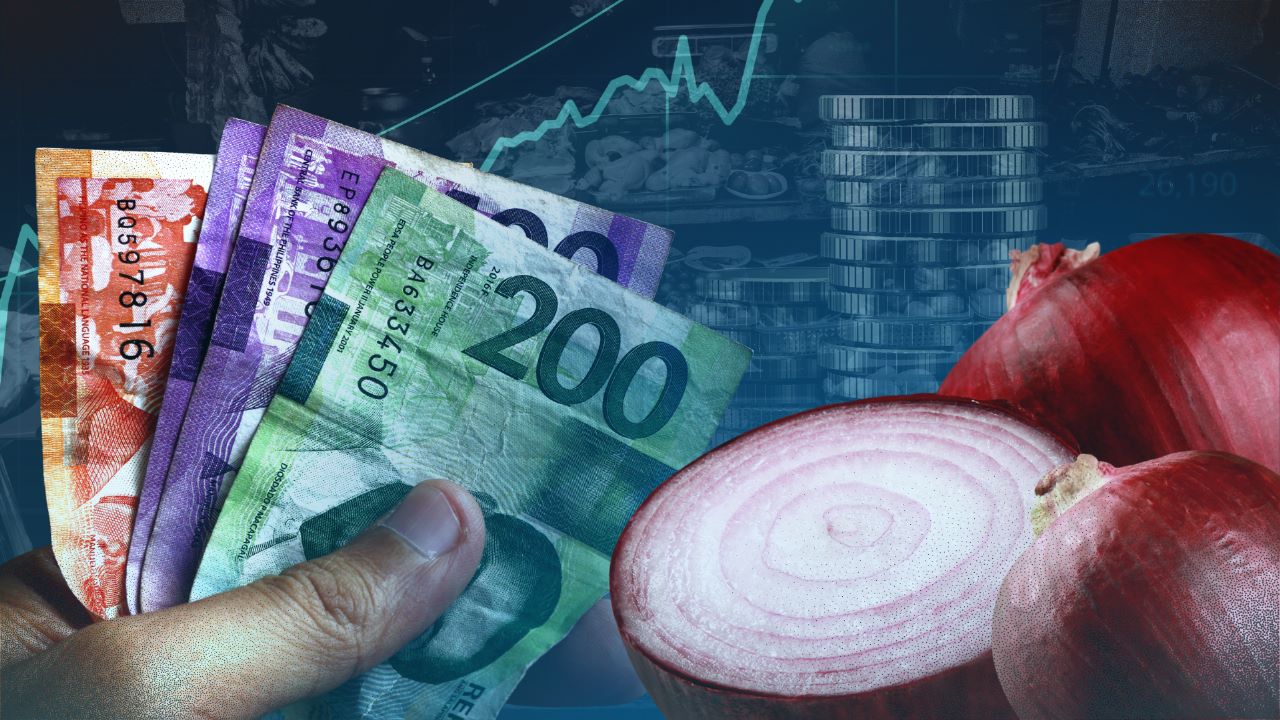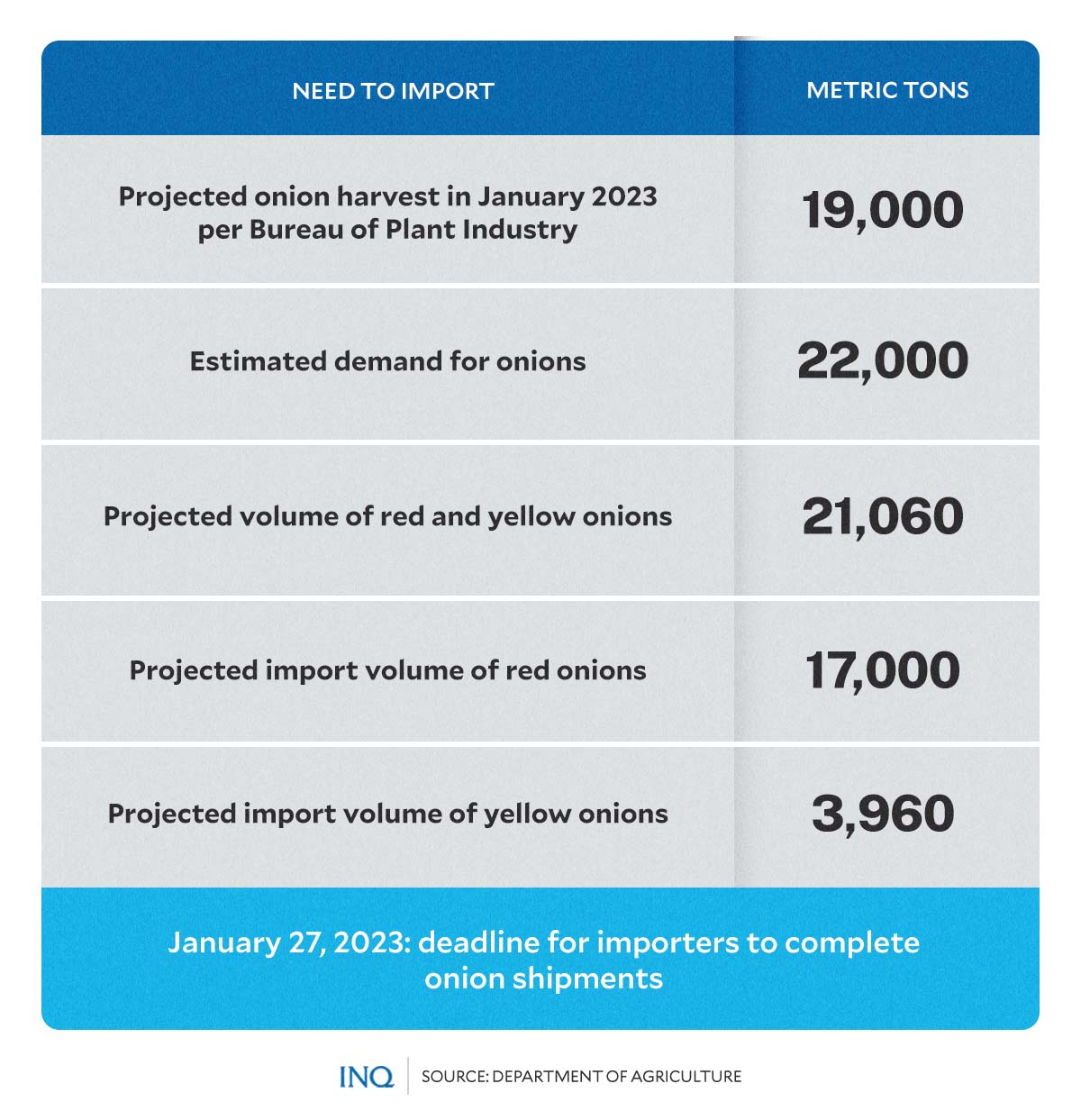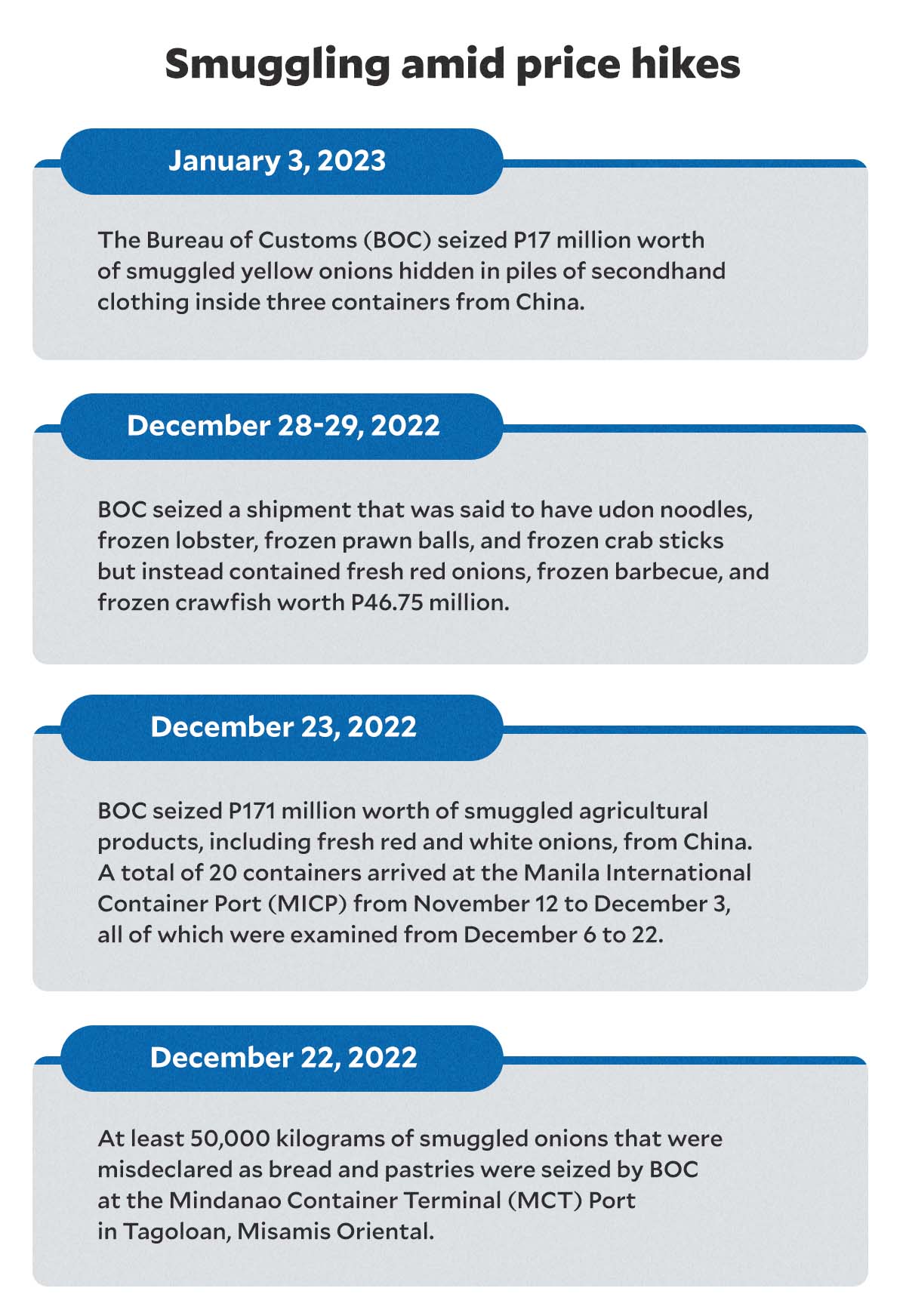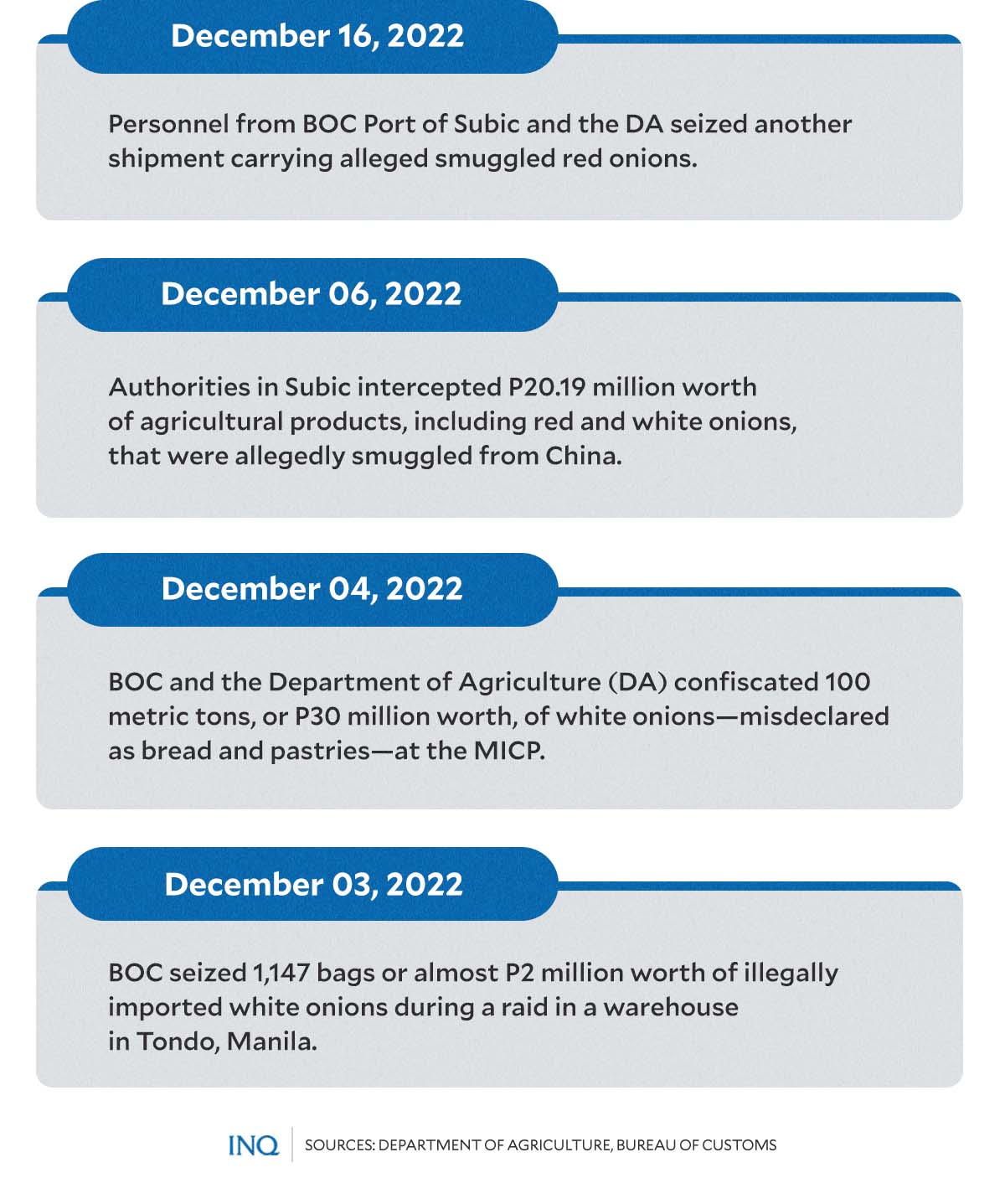The PH onion conundrum: Solutions elusive, stop-gaps at best
(Second of two parts)
MANILA, Philippines—As Filipinos continue to tighten their belts and opt for dishes without onions as prices of the staple vegetable continue to rise, the government is under pressure to find solutions.
Based on the Department of Agriculture’s (DA) price monitoring, as of January 10, a kilogram of red or white onion costs P420 to P600. This makes the vegetable more expensive than a kilogram of whole chicken—worth P180 to P220—or a kilogram of beef brisket or rump, which costs between P350 and P480.
With many consumers crying over the continuing price increase of onions, and as legislators investigate and search for the reason, the government is now being pushed to find ways to bring down onion prices.
READ: What we know so far about ‘out of control’ rise in onion prices
This is even if some of the solutions are just band-aids or are riddled with officials changing statements on the issue like they change clothes.
Importing onions
Last December, despite earlier warnings of a possible onion shortage and as prices in public markets reached P600 a kilo, the DA stressed that it was not considering importation since there was enough supply.
The department previously said the government could import up to 7,000 metric tons of red onions to stop the price spike but only if proven that there was, indeed, a shortage.
READ: DA finds red onions hitting P600/kilo, still assures enough supply
Last January 5, however, DA deputy spokesperson Rex Estoperez described the onion price spike as “out of control,” and importation may be resorted to as a “band-aid solution” but only if prices continued to soar.
READ: DA: ‘Out of control’ rise in price of onion may force PH to import
Citing estimates from the Bureau of Plant Industry, Estoperez also said that local onion harvest for January this year was expected to yield 19,000 metric tons (MT).
Days later, the DA said that at least 22,000 MT of onions may arrive in the country by end of January if President Ferdinand Marcos Jr.—the concurrent agriculture secretary—approved the DA plan to import.
Last January 10, a memo signed by Agriculture Senior Undersecretary Domingo Panganiban noted that the department had authorized the importation of 21,060 MT of red and yellow onions to “address the supply gap prior to peak harvest in 2023 and to stabilize the continuous increase in price of fresh onions in the market.”
The approved importations—lower than earlier suggested figures—consists of 17,000 MT of fresh red onions and 3,960 MT of fresh yellow onions.
READ: DA authorizes importation of more than 21,000MT of onions
The DA gave licensed importers of red and yellow onions until January 27 to complete their shipments.
READ: Onion importers given till January 27 to ship supply to PH
Impact on local farmers
However, according to Raul Montemayor, national manager of the Federation of Free Farmers (FFF), the decision to import onion might hurt local farmers.
While the harvest season varies per province, onions are usually harvested between February and April or around four months from the time they are planted between November and January.
This means that if the DA-approved imports will arrive by end of January and reach markets in mid-February, local producers might have to compete directly with imported onions.
“If the imports are cheaper than local stocks, traders will bring down their prices to compete with imports at the expense of farmers. This will also allow them to buy low from farmers while giving them the opportunity to hold on to the stocks until prices go up during the off-season, as what happened last year,” Montemayor said.
Senate Minority Leader Aquilino Pimentel III previously questioned the timing of the importation for being close to harvest time. Senator Risa Hontiveros said it might be best to first wait for the harvest of local onions before making a huge importation of the crop.
READ: Hontiveros says ‘wait and see’ local onion farmers’ harvest first before importing crop
The Office of the Ombudsman had summoned officials of the DA and the Food Terminal Inc. (FTI) for an investigation over the decision to import the produce when the local harvest season is about to start and the alleged procurement of some P140 million worth of onions from a Nueva Ecija cooperative.
Setting lower SRP
Earlier this week, Agriculture Assistant Secretary and Spokesperson Kristine Evangelista assured the public that the DA might soon set a lower suggested retail price for onions, which, as its name suggests, is simply a suggestion.
Last December, the DA set a suggested retail price (SRP) for red onions at P250 per kilogram—higher than the P170 per kilogram SRP set by the DA last October.
READ: DA sees lower SRP for onions by second week of January
Montemayor, however, noted that there was no need to lower the SRP of onions since prices of will “naturally go down” by end of January or when the local harvests start to come in.
In the House of Representatives, the Makabayan bloc previously said that setting an SRP for onions “is, at best, a band-aid solution to the exceedingly high prices of onions in the country.”
READ: SRP on onion a ‘band-aid’ solution, gov’t should help farmers — Makabayan
To sell or not to sell?
Aside from rising prices of onion, another onion-related issue that has been plaguing the country since last year was the millions of pesos worth of smuggled onions seized by the Bureau of Customs (BOC) in several shipping containers from China.
In a statement last January 12, the BOC said it had seized over P153 million worth of smuggled fresh red and white onions from China. The agency said seven containers of the smuggled produce were intercepted at the Manila International Container Port – Customs Intelligence and Investigation Service (CIIS-MICP).
READ: BOC seizes P153 million smuggled onions from China
Discussions and decisions on whether the government should sell the seized smuggled onions at discounted prices, however, have been going back and forth since last month.
Last December 6, Estoperez said the confiscated commodity would have to undergo a phytosanitary test to determine if they are safe for human consumption. This would help the DA decide whether the smuggled onions could be sold at government-run Kadiwa stores.
READ: Gov’t mulls sale of smuggled onions via Kadiwa
The DA, later on, decided not to sell the smuggled onions—specifically those confiscated in November—saying that these were deemed unsafe for consumption.
READ: Smuggled white onions deemed unsafe, won’t be sold via Kadiwa
READ: Seized smuggled onions can help cut prices, Customs says
Last December 17, Marcos himself said the government is finding ways to deal with the tons of smuggled onions that have entered the country illegally and release those to the market.
A week after, the president reiterated his statement. He said that the government is “trying to find ways to bring the smuggled onions that have been caught in the markets in order to reduce the supply problem.”
Marcos, however, noted that there might be some legal issues with doing that immediately.
Last week, Estoperez said the DA was still studying measures on how legally to release the confiscated onions to the market.
Last Tuesday, Marcos ordered the phytosanitary inspection of smuggled onions to ensure their safety before they are released to the market.
“Since we have been seeing and seizing smuggled onions, I am trying to get them out to the markets, but unfortunately, we do not know the source of these onions, so they all have to be inspected.”
READ: Marcos orders smuggled onions checked before selling
Other recommendations
To help address the country’s onion price crisis, Montemayor suggested that the DA and the agriculture secretary create a task force to map out a plan—which involves all stakeholders.
Marcos, he said, must issue directives to ensure that the approved plan will be carried out. This way, Montemayor stressed, the government could implement long-term solutions and not just stop-gap plans.
“To protect consumers, the government must constantly monitor stocks, anticipate supply shortages and allow imports to come in at the proper time, and set up alternative marketing systems to prevent traders from taking excessive advantage of tight supply situations during the off-season,” Montemayor said.
“At the same time, the government must ensure that farmers get reasonable prices for their crops at harvest time to give them the incentive to continue producing. Otherwise, local production will drop, we will become more dependent on imports, and traders will again take advantage of the situation to prey on consumers,” he continued.




